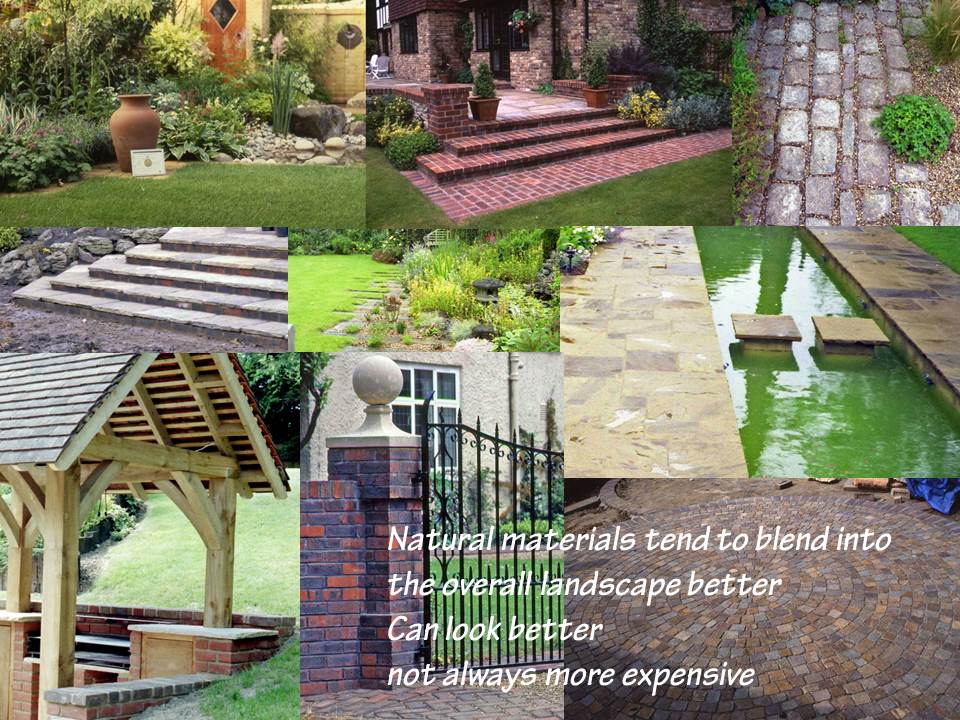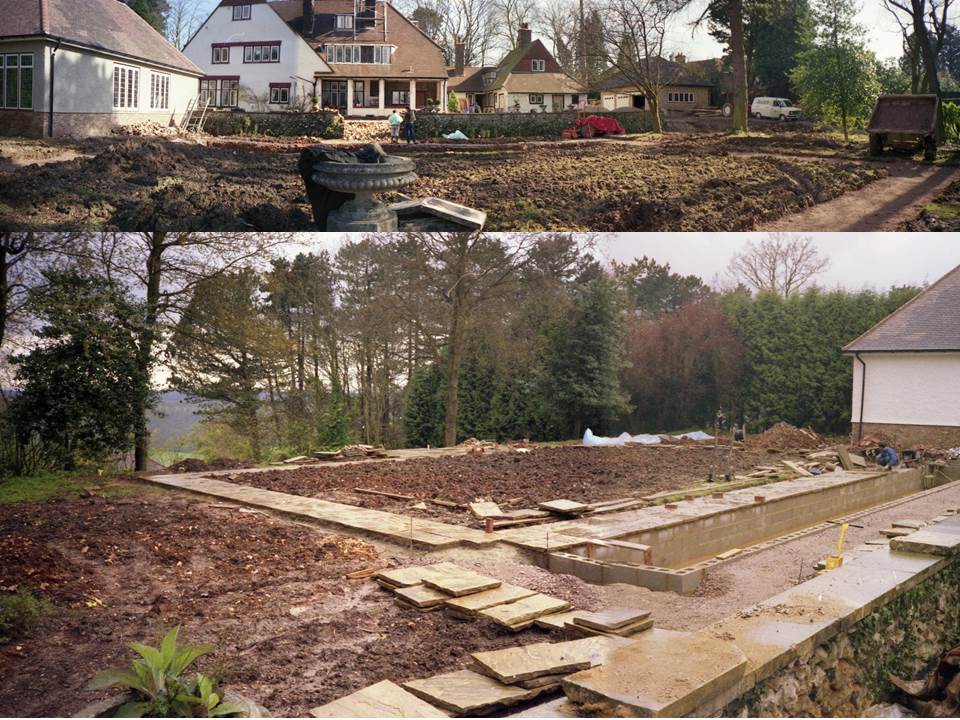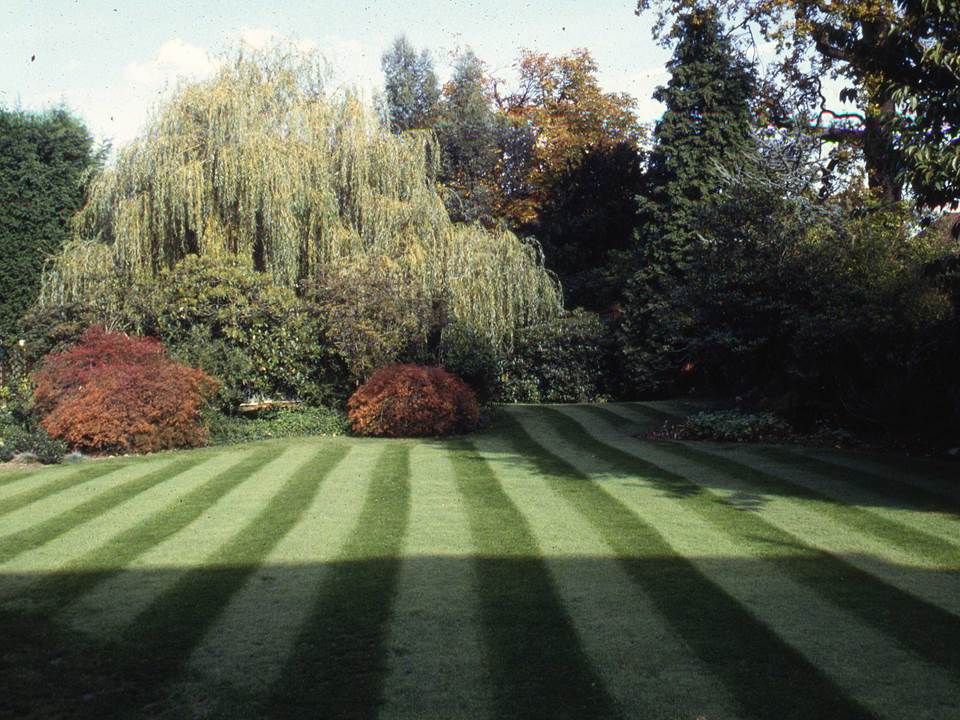-
School ‘themed’ garden
One of my favorite projects is a themed garden for a Primary School in
South London.
The idea was to create a ‘dry’ replica of a Kentish Riverside,
on what was a tarmac car park.
We achieved this by starting with a ‘dry’ riverbed of kidney stones
laid in a flowing pattern, with ceramic fish set into them.
Next we designed and built a miniature Oast house, and
a Kentish Barn.To comply with disability access requirements we added a
jetty to the dock.
Then constructed three mock sailing boats using trees as masts( to facilitate shade in the Summer months).
We also added a typical stone bridge, a gravel path around the
garden area, and a fallen tree ( depicting the great storm of 1987).
Here you can see the ceramic fish set into the dry stone riverbed.
Here you can just make out the natural stone bridge.
The idea was to use all local materials so that whilst the ‘garden’
was created to be a quiet rest area during breaks it also had
some educational historical significance.
We took a little ‘licence’ with the barn, but kept the materials authentic.
When it came to planting, we arranged for each child to plant at least one plant,
some plants ended up being planted more than once.The end result won a number of awards, and was remarkably free from any vandalism.
Views: 38
-
When you really put your foot in it !

When you design and build with a number of highly skilled teams, you often can only see a client in the early evening when they come home from work.
This particular evening it was getting late around 8pm, I was a tad tired from driving perhaps 140 miles that day, and wanted to get home.
The client a Brazilian banker, loved detail.. I mean he kept a little book, with jottings in ( it was way more detailed than my site notes – I only kept up because I took pictures of everything).
This particular night we were looking at his pool – not the one in the picture ( I used that as an example) No this pool was an in ground 25 year old pool with a cover, never been emptied and he wanted the pool taken out. Removing 25 year old reinforced concrete pools is hard work, we used to get two a year on average, due to the huge cost of keeping the water warm enough to enjoy a swim.
So this night I’m dressed in a suit, walking next to the client when suddenly, my feet are sort of floating, I had missed the dogleg step area jutting out of the pool and was now attempting to tread water on top of a very old fabric cover, which was tearing fast as I scrambled to get out of this disgusting green smelly liquid..
The client saw what had happened, and ran off to the kitchen… I thought to find perhaps a towel.. but alas no, when I managed to get out somewhat bedraggled, on reaching the back door I hesitated to enter as I was dripping this green smelly liquid everywhere.. I heard ” Darling come quickly with a camera..Mr Coope has fallen in the pool”.. this brought not only his wife but the children as well…who took a few pictures while I sheepishly tried to leave.
The 40 minute drive home was filled with the aroma of a swimming pool that hadn’t been touched in 5 years and the thoughts of what my kids might say, when I finally arrived home !
Views: 31
-
An amusing moment reviewing a Roof Garden
A good few years ago we were asked to design and build a roof garden on an office roof.
There are a few extra considerations needed when doing this.
All roofs will have a weight restriction – this includes a snow loading and a people loading
Access is severely restricted unless a tower crane is still on site, when it’s the crane lifting ability and movement.
Wind levels play a part with plants survival, and also with ‘lifting’ light weight materials
Irrigation is essential – as to is adequate drainage and roof waterproofing
Finally ongoing site safety – railings, balconies , restricted access to the parapet.
On this occasion the roof had been completed, we had even received an award for the design and construction.

Rock faced planter I have always liked this one..
We were commissioned to Design and Build a roof garden, to comply with a local planning condition.
So we utilised artificial rocks made from GRP – we took moulds of actual rock faces and pieced them together to form a sealed planter – First picture
Then we joined these together added compost and plants …. the result an award winning roof garden..
There was a funny moment when a visiting Japanese manager of the company we were working for, came up to me one evening while I was checking the summer planting one year.He bowed formally ( the Japanese are so polite), any way after bowing he tapped on the rock and said ” Ah Rock “
I , with a slight smile, bowed and tapped the rock and and said “No Plastic” !!To which he looked puzzled and then smiled ,then saw the humour in the situation and roared with laughter… we kept the contract for many more years !!

Super light weight planters Views: 205
-
Green Walls
We built our first green wall in 1984, in rural Kent, not far from a famous racing circuit. The wall was built on a chalk escarpment so to make it more interesting we added plants into the wall, the wall was fully structural, quick and easy to build. As you can see quite a wide variety of plants was used to see what would develop best in this situation.
Views: 57
-
Ground Preparation
It seems that Spring or is it Summer has finally arrived to the MidWest ?
It’s at times like these when one misses being in England with it’s very much milder climate, although their winter was a tad wetter than normal ( I hear wetter than the past 200 years !).
So back to the MidWest, the bunnies are hopping around, the snakes are emerging, grass has turned green, buds are bursting and flowers are appearing, hardy folks are out and about in their yards, starting to tend the vegetable gardens in ernest.
With that in mind I thought it might be an idea to talk a little about the various methods to use to prepare ground for planting.
Easy Way :
The easiest way to prepare ground is to first cut down any vegetation to as close to the ground as possible – rotary lawn mowers are good for this, so long as you have walked over the ground and removed any large stones, branches or other debris, it also helps if the found is reasonable flat.
Next all that you need to do is to cover the area to plant in a thick coating of newspapers, then cover these with reusable landscape fabric and secure in place.
It takes about 4 – 6 weeks to clear all the growth beneath, but when you do lift off the landscape fabric ( carefully as you can keep this for future use) and then removed the newspaper you should find bare soil beneath. Simply replace the landscape fabric and plant through this to complete you project.
Harder Method :
Cut down the growth on the area – usually with a rotary lawn mower ( do check for objects first).
Now for the fun part, stripping off the growth, this can be a strenuous operation if you use say a spade to ‘chip’ the grass and weeds off, alternatively you can use a rototiller and take a quick romp across the hard ground until a fine tilth is established, of course you have just spread a kazillion weed seeds as you do this. If the ground really is ‘too hard’ it helps to soak the area with water the day before.
Now all you need to do is to rake to an even level – do make sure that the ground slopes away from buildings, as when it rains you don’t want the ground to become waterlogged or allow water to accumulate near walls or on paths etc.,
Finally you can place and secure the landscape fabric, and complete the planting of your project.
Planting :
The planting technique is basically the same for both techniques :-
- Water thoroughly all plants to be planted.
-
Keep plants in shady position until planting.
-
Cut a 6 inch ‘x’ in the landscape fabric in the desired planting position
-
Dig a hole approximately 50% larger all-round than the plant pot.
-
Keep this soil nearby.
-
Add a small amount of planting compost to the base of the pit, together with fertilizer and if you have it a corn based super absorbent.
-
Mix these materials together and add some water until you have a ‘porridge’ or as ‘she’ who must be obeyed would say a ‘mud pie’
-
Select plant, tap edge of container to facilitate removal of pot, and carefully place in pit.
-
Carefully backfill soil around plant and firm into position.
-
Fold back landscape fabric carefully to the stem of the plant.
-
Apply approximately 2-3 inches of mulch ( keep at least 2 inches away from plant stems)
-
Water thoroughly, and again every other day for the first two weeks.
Views: 72
-
We’re ready to record our radio show..!

We would really like to hear what you think about our program, and to ask you what you would like to hear on the show, or even be interviewed about any of the topics we are planning to present.
Here’s a typical weeks content:
The show is intended for the homeowner, with input from homeowners & experts around the world.
Discussing Edibles, Vegetables and Herbs, what are the easiest to start with, where & how should I grow them.
An interview with a homeowner that grows veggies and herbs interspersed within flower borders – growing peppers, rosemary, parsley, beans,cabbage, lettuces, tomatoes, etc., are quite easy,
Amusing anecdotes from some 40 years of landscaping gardens & commercial sites across the globe.
Interviewing a small organic vegetable farmer in the MidWest, what they are growing ,how they get to market…
Around the world trends in growing vegetables & herbs from our colleagues abroad, looking at for example – Allotments in England, Balcony raised beds in Europe,
The next week will be:
Choosing the right plant – how to plant, prune, and maintain flower beds and plant containers.
Interviewing a sustainable garden designer in the USA – how to save water, prepare ground, aftercare, etc.,
More anecdotes from around the globe.
Trends in Playgrounds, Roof Gardens, Paving, Parks, Grass areas from around the world..
If you have a question you would like ask, please send us an email with the question we will try and answer questions each week, we may even call you ! We will also send you details of where you can hear the program.
As the program will be on internet radio, it will be possible to record directly from the web, enabling you to play back when its best for you.
Your message has been sent
Views: 39
-
Soft natural garden area

Using natural materials almost always creates a much softer and pleasing finish, here the gravel and granite setts, with the planting make a superb xeriscape garden, requiring very little aftercare.
Views: 32
-
Tiger Rhus

Don’t you think there is something incredibly relaxing about looking at soft architectural plants in the right setting ?
Views: 31
-
A typical English garden landscape

We were very fortunate to be able to design and build two adjoining executive properties.

We worked with this client for a number of years, developing his garden into this beautiful, peaceful retreat from everyday stresses..
Shortly after completion we became one of the first Toro irrigation installers in London. With a certain amount of ingenuity we found a way to instal irrigation in an existing landscape without creating too much damage.
Have a look at our blog “No trenching Irrigation Installation”
Views: 148
-
Some tips and tricks for that dream landscape
A somewhat larger residence, with a lovely brick gulley detail.
Our first green wall way back in 1984, this superb timber product (guaranteed for 50years) is fully structural to a retained height of about 27ft (9m), this wall is about 14ft in total, and terraced to make the best use of the available space. We added the planting to give this steeply slopping garden a softer look.
This larger residence was developed as a modern Arts & Crafts style garden, using random rectangular yorkstone paving, natural bricks and knapped flint walls – knapped flint is a difficult product to use, necessitating us to develop a modern approach to using a ‘live sand/lime mortar, we added stainless steel butterfly ties every 9 inches ( 250mm) to enable a quicker laying time.
Finally the classic English stripped lawn…from one of our clients gardens
Views: 43







































